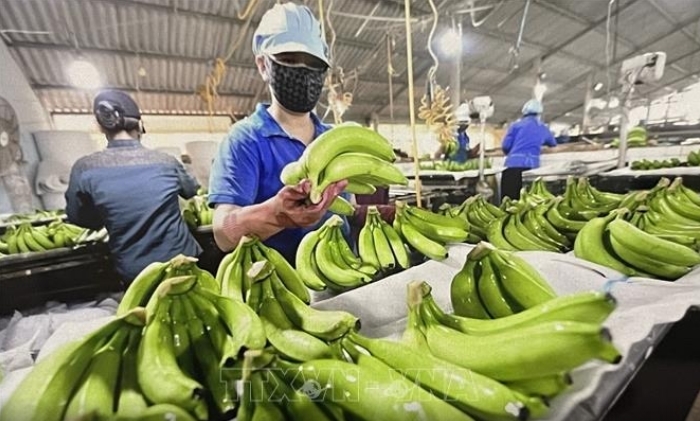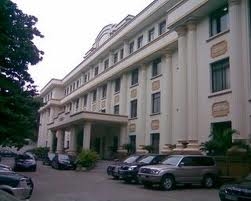Passion fruit, banana, pineapple, coconut: A group of billion-dollar fruits waiting to break through
Thursday, July 24,2025
AsemconnectVietnam - With competitive advantages, production capacity and market demand, passion fruit, banana, pineapple, coconut can earn tens of billions of USD/year if production and export are done well.
Maintaining a single quality standard
“From zero 10 years ago, passion fruit industry has created significant economic value and has the potential to reach the 1 billion USD mark if planning is good and the Chinese market expands”, Mr. Nguyen Manh Hung, Chairman of the Board of Directors of Nafoods Joint Stock Company, shared.
Vietnam's purple passion fruit, especially Nafoods', is strongly welcomed by the world as fresh fruit, different from the sour yellow variety in South America. Europe is an important export market for fresh fruit, estimated at 5,000-7,000 tonnes per year.
Regarding market potential, Mr. Hung estimated that the global demand for passion fruit concentrate and puree is about 30,000 tonnes per year, with a growth rate of 6-7% but not unlimited. However, if the Chinese market opens, it will create a huge demand for fresh fruit, especially in winter when they cannot grow.
Vietnam's passion fruit productivity is more than double that of South America (40 - 60 tonnes/ha compared to 15 - 20 tonnes/ha), bringing a great competitive advantage in terms of production costs (about 20,000 VND/kg of fruit) and export prices (60,000 - 70,000 VND/kg). In particular, Nafoods' sweet passion fruit variety can be sold at the garden for 80,000 - 100,000 VND/kg and up to 230,000 VND/kg at supermarkets. This shows great economic potential, each hectare of passion fruit can bring in about 1 billion VND in revenue for farmers. In an increasingly competitive and quality-demanding fruit market, Unifarm, a company chaired by Mr. Pham Quoc Liem, is steadfastly pursuing a special strategy with bananas: "Developing with high technology and maintaining a single quality standard, throughout from the variety to the market".
While many domestic banana producers can be flexible between standards such as VietGAP, GlobalGAP, or individual standards of each import market, Unifarm chooses the opposite approach: Unifying processes and quality, from seeding, cultivation, post-harvest processing to traceability.
In 2024, banana exports will bring Vietnam 378 million USD, equivalent to about 2,400 USD/ha, Mr. Liem said, this is an income level that is not commensurate with the potential. Setting a higher goal, Unifarm focuses from the first step of selecting and developing varieties. According to Mr. Liem, banana varieties must have high yield, good quality and be resistant to Panama wilt - a dangerous disease that is threatening many banana growing areas in the world.
Not just stopping at a few hundred million USD, Unifarm expects the Vietnamese banana industry to reach an export value of 4 billion USD in the near future. This means that the production value must reach at least 20,000 USD/ha, nearly 10 times higher than the current level. This is not an easy goal, but according to Mr. Liem, it is completely feasible if the whole industry aims for large-scale production, applying high technology and maintaining consistent quality.
"In the current context, people's health and the environment also need attention. If this can be achieved, Vietnamese bananas will have more competitive advantages, especially in demanding markets such as the EU and Japan," said Mr. Liem.
Mr. Vo Quan Huy, Director of Huy Long An Company Limited, said that in the context of an increasingly competitive fresh banana market, developing deeply processed products and by-products is an inevitable step if Vietnam wants to upgrade the banana industry and avoid dependence on a few traditional export markets.
Currently, most Vietnamese bananas are exported in the form of fresh fruit, mainly to China, Korea, Japan and some Middle Eastern countries. Meanwhile, products such as dried bananas, pressed bananas, banana wine, banana cakes or green banana powder, which have higher value, are still on a small and fragmented scale.
According to Mr. Huy, this is partly due to the lack of policies to promote a systematic banana processing chain and the lack of large-scale investment projects. In addition, the economic potential of banana by-products is also very large. "If we know how to take advantage of them, a banana tree can produce 5-7 products with use or commercial value," he said.
To unlock this potential, Mr. Vo Quan Huy proposed a policy to prioritize the development of the banana processing industry, supporting businesses in accessing capital, science - technology and domestic and foreign consumption markets. At the same time, there needs to be a research and technology transfer program to make the most of banana by-products, instead of throwing them away, causing waste or polluting the environment as is currently the case.
A "technological revolution" is needed for 4 main fruits
The total cultivated area of 4 fruits: banana, passion fruit, pineapple and coconut is currently about 420,000 hectares with an output of over 6.3 million tonnes, however, the total export turnover of these 4 fruits has only reached 1.752 billion USD. With competitive capacity, production and potential market demand, therefore, from the perspective of the State, cooperatives, growers... there is still a lot of work to do to bring these products to the billion-dollar level, possibly in 2026 or 2027.
Deputy Minister of Agriculture and Environment Tran Thanh Nam said that a "technological revolution" is needed for these 4 main fruits. In particular, the issues that need to be focused on are varieties.
According to Deputy Minister Tran Thanh Nam, Decree No.88/2025/ND-CP guiding the implementation of Resolution No.193/2025/QH15 has removed many barriers, opening up breakthrough opportunities in the research of new varieties. This is time when institutes and schools need to focus on improving and diversifying seed sources, while businesses must increase investment and proactively link up in the seed production process.
Also according to Deputy Minister Tran Thanh Nam, currently, the decentralization to local regions according to Decree No.145/2025/ND-CP sets out 17 tasks for each commune regarding raw material areas and granting planting area codes. This is an important basis for localities to proactively coordinate with businesses and cooperatives in managing and developing planting areas in a systematic and effective manner.
Particularly for raw material areas, businesses need to proactively coordinate with cooperatives to build a model of close linkage from input to output. This is a key factor that not only ensures a stable source of raw materials and traceability, but also enhances the competitiveness of Vietnamese agricultural products in the international market.
Source: Vitic/ congthuong.vn
“From zero 10 years ago, passion fruit industry has created significant economic value and has the potential to reach the 1 billion USD mark if planning is good and the Chinese market expands”, Mr. Nguyen Manh Hung, Chairman of the Board of Directors of Nafoods Joint Stock Company, shared.
Vietnam's purple passion fruit, especially Nafoods', is strongly welcomed by the world as fresh fruit, different from the sour yellow variety in South America. Europe is an important export market for fresh fruit, estimated at 5,000-7,000 tonnes per year.
Regarding market potential, Mr. Hung estimated that the global demand for passion fruit concentrate and puree is about 30,000 tonnes per year, with a growth rate of 6-7% but not unlimited. However, if the Chinese market opens, it will create a huge demand for fresh fruit, especially in winter when they cannot grow.
Vietnam's passion fruit productivity is more than double that of South America (40 - 60 tonnes/ha compared to 15 - 20 tonnes/ha), bringing a great competitive advantage in terms of production costs (about 20,000 VND/kg of fruit) and export prices (60,000 - 70,000 VND/kg). In particular, Nafoods' sweet passion fruit variety can be sold at the garden for 80,000 - 100,000 VND/kg and up to 230,000 VND/kg at supermarkets. This shows great economic potential, each hectare of passion fruit can bring in about 1 billion VND in revenue for farmers. In an increasingly competitive and quality-demanding fruit market, Unifarm, a company chaired by Mr. Pham Quoc Liem, is steadfastly pursuing a special strategy with bananas: "Developing with high technology and maintaining a single quality standard, throughout from the variety to the market".
While many domestic banana producers can be flexible between standards such as VietGAP, GlobalGAP, or individual standards of each import market, Unifarm chooses the opposite approach: Unifying processes and quality, from seeding, cultivation, post-harvest processing to traceability.
In 2024, banana exports will bring Vietnam 378 million USD, equivalent to about 2,400 USD/ha, Mr. Liem said, this is an income level that is not commensurate with the potential. Setting a higher goal, Unifarm focuses from the first step of selecting and developing varieties. According to Mr. Liem, banana varieties must have high yield, good quality and be resistant to Panama wilt - a dangerous disease that is threatening many banana growing areas in the world.
Not just stopping at a few hundred million USD, Unifarm expects the Vietnamese banana industry to reach an export value of 4 billion USD in the near future. This means that the production value must reach at least 20,000 USD/ha, nearly 10 times higher than the current level. This is not an easy goal, but according to Mr. Liem, it is completely feasible if the whole industry aims for large-scale production, applying high technology and maintaining consistent quality.
"In the current context, people's health and the environment also need attention. If this can be achieved, Vietnamese bananas will have more competitive advantages, especially in demanding markets such as the EU and Japan," said Mr. Liem.
Mr. Vo Quan Huy, Director of Huy Long An Company Limited, said that in the context of an increasingly competitive fresh banana market, developing deeply processed products and by-products is an inevitable step if Vietnam wants to upgrade the banana industry and avoid dependence on a few traditional export markets.
Currently, most Vietnamese bananas are exported in the form of fresh fruit, mainly to China, Korea, Japan and some Middle Eastern countries. Meanwhile, products such as dried bananas, pressed bananas, banana wine, banana cakes or green banana powder, which have higher value, are still on a small and fragmented scale.
According to Mr. Huy, this is partly due to the lack of policies to promote a systematic banana processing chain and the lack of large-scale investment projects. In addition, the economic potential of banana by-products is also very large. "If we know how to take advantage of them, a banana tree can produce 5-7 products with use or commercial value," he said.
To unlock this potential, Mr. Vo Quan Huy proposed a policy to prioritize the development of the banana processing industry, supporting businesses in accessing capital, science - technology and domestic and foreign consumption markets. At the same time, there needs to be a research and technology transfer program to make the most of banana by-products, instead of throwing them away, causing waste or polluting the environment as is currently the case.
A "technological revolution" is needed for 4 main fruits
The total cultivated area of 4 fruits: banana, passion fruit, pineapple and coconut is currently about 420,000 hectares with an output of over 6.3 million tonnes, however, the total export turnover of these 4 fruits has only reached 1.752 billion USD. With competitive capacity, production and potential market demand, therefore, from the perspective of the State, cooperatives, growers... there is still a lot of work to do to bring these products to the billion-dollar level, possibly in 2026 or 2027.
Deputy Minister of Agriculture and Environment Tran Thanh Nam said that a "technological revolution" is needed for these 4 main fruits. In particular, the issues that need to be focused on are varieties.
According to Deputy Minister Tran Thanh Nam, Decree No.88/2025/ND-CP guiding the implementation of Resolution No.193/2025/QH15 has removed many barriers, opening up breakthrough opportunities in the research of new varieties. This is time when institutes and schools need to focus on improving and diversifying seed sources, while businesses must increase investment and proactively link up in the seed production process.
Also according to Deputy Minister Tran Thanh Nam, currently, the decentralization to local regions according to Decree No.145/2025/ND-CP sets out 17 tasks for each commune regarding raw material areas and granting planting area codes. This is an important basis for localities to proactively coordinate with businesses and cooperatives in managing and developing planting areas in a systematic and effective manner.
Particularly for raw material areas, businesses need to proactively coordinate with cooperatives to build a model of close linkage from input to output. This is a key factor that not only ensures a stable source of raw materials and traceability, but also enhances the competitiveness of Vietnamese agricultural products in the international market.
Source: Vitic/ congthuong.vn
Leather and footwear exports grew by double digits
Daily: Domestic pepper prices down 500–2,000 VND/kg on July 23, 2025
Daily: Domestic rice prices rose slightly on July 23, 2025
Daily: Domestic coffee prices rose slightly on July 23, 2025
Fruit and vegetable exports are estimated to exceed 3.8 billion USD after 7 months, aiming for a target of 8 billion USD
Imports and exports approaches 500 billion USD mark
Spain, Algeria become new bright spots for Vietnamese coffee
Update on Vietnam’s fruit market situation as of mid-July 2025
Exports to Japan increased in first 6 months of 2025
Major commodity groups exported to South Korea in first 6 months of 2025
Vietnam - Singapore two-way trade in first 6 months of 2025
Chemical exports to Laos increased sharply in first half of 2025
Vietnamese pineapples 'at a good price' in Europe: Will billion-dollar dream come true?
Daily: Domestic rice prices stable on July 18, 2025

Plan of Hai Duong province for a period of 2021 - 2030, ...
Organize space reasonably and harmoniously, focusing on connecting Hai Duong in common development space, actively contributing to the ...Plan of Hau Giang province in a period of 2021 - 2030, ...
Sustainable forestry development program in a period of ...

AI opens new path for image industry: Insiders
Though the term "image industry" remains relatively new in the local context, the development of a creative ecosystem driven by AI will ...Hanoi’s street food culture gains ground with Michelin nods
Draw held for 2025 Davis Cup Asia/Oceania Group III in Bac ...
Da Nang Museum opens an exhibition of rare ancient ...
An Giang races to complete UNESCO nomination dossier for ...



